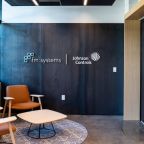The workplace is undergoing a major transformation, driven by the rise of hybrid work models, where employees split their time between working remotely and in the office. This shift has introduced new challenges and opportunities in office space management. As companies adapt to this evolving reality, they must rethink how to design, manage, and utilize their physical office spaces.
In this article, we will look at current trends in office space management. We will focus on the rise of hybrid work environments. We will also see how companies create flexible workspaces for both in-person and remote employees.
We will also look at advanced technology for tracking space use. These strategies and tools help companies succeed in this new era. We’ll also look at some of the potential challenges of hybrid workspaces and how to overcome them.
The Rise of the Hybrid Work Model
The hybrid work model has gained momentum, particularly after the COVID-19 pandemic. Many employees prefer flexibility, so many businesses now allow workers to split their time between the office and home. According to recent studies, more than 70% of employees express a desire to continue working in a hybrid environment.
This new approach requires significant changes in how office spaces are managed. Traditional office layouts were made for full-time work in the office. Now, many desks sit empty each day. To meet the demands of a hybrid workforce, office spaces must become more flexible, efficient, and adaptable.
Key Trends in Office Space Management for Hybrid Work
# 1. Designing Flexible Workspaces
One of the most significant trends in office space management for hybrid work is the rise of flexible workspaces. These spaces are designed to be adaptable, allowing employees to choose where and how they work, depending on their tasks. The focus is on creating versatile areas that can easily transition between individual work, team collaboration, and even remote participation in meetings.
Hot desking is one popular solution. In this model, employees do not have assigned desks but can choose any available space to work from when they come into the office. This allows companies to reduce the number of fixed workstations and make better use of their office space, especially when not all employees are present at the same time.
Similarly, multi-functional spaces are becoming more common. These spaces can serve as a meeting room, collaboration hub, or quiet zone, depending on what’s needed. Movable furniture, mobile partitions, and modular design elements are key to enabling this flexibility.
# 2. Leveraging Advanced Space Management Tools
As hybrid work becomes more common, companies track how employees use office spaces with advanced tools. These tools provide real-time data on office occupancy, employee movement, and space utilization, helping businesses make informed decisions about how to optimize their spaces.
For example, occupancy sensors monitor which desks, meeting rooms, and common areas people use. They also track the frequency of use for these spaces. This information allows companies to adjust layouts, identify underutilized areas, and reduce wasted space. By using this data, organizations can plan better for peak times, reduce energy consumption, and even redesign spaces based on actual usage patterns.
Additionally, space management software often includes booking systems that allow employees to reserve desks or meeting rooms in advance. This helps ensure that office spaces are used efficiently and reduces the risk of overcrowding or underuse.
# 3. Supporting Both In-Person and Remote Collaboration
In a hybrid work environment, it’s essential to support seamless collaboration between in-office and remote employees. This has led to the rise of hybrid meeting spaces equipped with advanced technology that allows employees to participate equally, whether they’re in the office or joining remotely.
Investing in high-quality video conferencing tools, such as large screens, microphones, and cameras, is crucial for creating a cohesive communication experience. Smart meeting rooms with collaboration software like Zoom, Microsoft Teams, or Slack help teams work together easily. This is true no matter where team members are located.
In addition to technology, the design of these meeting spaces is changing to accommodate hybrid teams. Circular seating arrangements, for example, ensure that everyone in the room has equal visibility and participation, creating a more inclusive environment for remote workers joining virtually.
# 4. Prioritizing Employee Health and Well-Being
With hybrid workspaces becoming the norm, companies are focusing more on designing spaces that support employee health and well-being. This includes ensuring that offices are safe, comfortable, and conducive to productivity.
A significant trend is the inclusion of biophilic design elements, which incorporate natural materials, plants, and light to create a more calming and inviting environment. Studies have shown that access to natural light and greenery can improve mood, reduce stress, and enhance cognitive function.
Also, keeping good air quality, lowering noise levels, and providing ergonomic workstations are important. These factors help create a workspace that employees like, even if they work from home and the office.
Challenges of Hybrid Workspaces and How to Address Them
While hybrid workspaces offer flexibility and freedom, they also come with certain challenges. Let’s look at some of the potential issues and strategies to address them.
# 1. Maintaining Company Culture
One of the biggest concerns for companies transitioning to a hybrid work model is how to maintain a strong company culture when employees are no longer physically together every day. The spontaneous interactions that foster relationships and innovation in the office can be harder to replicate in a hybrid environment.
To maintain culture, companies need to be intentional about creating opportunities for connection. This might involve scheduling regular in-person team-building events or ensuring that remote employees have access to virtual coffee breaks or social hours. Additionally, encouraging cross-departmental collaboration through shared spaces (both physical and virtual) can help sustain a sense of community.
# 2. Space Utilization and Overcrowding
In a hybrid office, it’s easy to either underuse or overcrowd certain areas. Without careful planning, companies might find themselves with too many empty desks on some days and not enough on others.
To solve this issue, dynamic space management is crucial. Companies should invest in tools that allow them to monitor office use in real-time and adjust layouts as needed. By offering desk reservation systems, businesses can manage capacity more effectively and prevent overcrowding.
# 3. Balancing Remote and In-Person Workloads
Another challenge in a hybrid workspace is ensuring that remote employees are not left out of important conversations or opportunities for advancement. Proximity bias happens when managers and team leaders pay more attention to employees they see in person. This can be a big problem.
To address this, leaders need training to promote inclusive communication. They must ensure remote workers have equal access to projects, feedback, and promotions. Regular check-ins, clear performance metrics, and collaborative digital platforms help keep remote employees engaged and visible, even when they’re not physically present.
Future-Proofing Office Spaces for Long-Term Flexibility
As the hybrid work model becomes more common, businesses must prepare their office spaces for the future. They should design these spaces for long-term flexibility. This means creating an office environment that can easily adapt to changes in team size, employee preferences, and work schedules.
Modular office designs that allow for easy reconfiguration are becoming more popular. These designs enable businesses to quickly adjust their space to meet evolving needs, such as downsizing certain areas or expanding collaboration zones.
Companies are also starting to embrace co-working models, where businesses share office spaces with other companies. This allows them to scale their physical space up or down depending on workforce needs, without the long-term commitment to a single office lease.
Conclusion
The hybrid work model is here to stay, and with it comes a new era in office space management. From designing flexible, multi-purpose spaces to leveraging advanced technology for monitoring occupancy, businesses are finding innovative ways to support both in-person and remote employees.
By tackling the challenges of hybrid workspaces, companies can improve their environments. They can maintain company culture and prevent overcrowding. This leads to spaces that are efficient and support collaboration, creativity, and well-being.
In the future, office space management will change. The focus will be on more flexibility and health-conscious design. We will also see a more dynamic, data-driven way to use these spaces. For companies that get it right, the hybrid office presents an opportunity to build a workplace that truly supports the diverse needs of the modern workforce.
FAQs
1. What is a hybrid work model?
A hybrid work model is a flexible arrangement where employees split their time between working remotely and in the office.
2. How can companies maintain company culture in a hybrid environment?
By creating intentional opportunities for connection, both in-person and virtually, and fostering inclusive communication practices.
3. What are some key tools for managing hybrid workspaces?
Space management software, occupancy sensors, and desk booking systems are crucial for optimizing space utilization in hybrid offices.
4. How can businesses avoid overcrowding in a hybrid office?
By using real-time space tracking tools and implementing desk reservation systems to manage capacity effectively.
5. What design elements support hybrid work?
Flexible workspaces, modular designs, biophilic elements, and smart meeting rooms that support seamless collaboration between in-office and remote workers.










